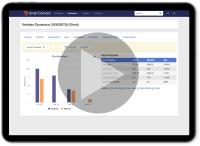EMPOWER YOUR PRICING TEAM
The Pricing Cockpit empowers pricing teams to define accurate pricing policies, monitor performance, and oversee AI-driven recommendations generated by intelligent models, simulations and optimization.
PRICING POLICIES
Easily define the target rate card for each product with the corresponding application conditions as well as multi-factor discount rules and the price of services and surcharges. The platform supports a wide variety of pricing methods used in the logistics industry. These rate structures can be simulated instantly on customers’ actual or expected shipping profiles.
List Price
Find the correct list price for your products and services based on the analysis of transactions, i.e. the rates that are acceptable by a significant percentage of your customers. This results in a coherent price that will be the reference for your discount and markup policy.
COSTING ENGINE
Model unit costs by activity with the relevant cost drivers (parcels, shipments, weight, volume of parcel, pickup stops, delivery stops…) for each relevant combination of dimensions (product, origin, destination, type of object…). Apply the model to shipments or aggregates of shipments and provide profitability reports by customer, product, destination and weight band.
List Price
Find the correct list price for your products and services based on the analysis of transactions, i.e. the rates that are acceptable by a significant percentage of your customers. This results in a coherent price that will be the reference for your discount and markup policy.
PERFORMANCE DASHBOARD
Enable your pricing teams and sales management to track pricing KPIs including: Adoption, of the platform by users; Adherence to recommendations, Conversion rate and Margin capture. These KPIs are available by product category, customer segment and sales team.
List Price
Find the correct list price for your products and services based on the analysis of transactions, i.e. the rates that are acceptable by a significant percentage of your customers. This results in a coherent price that will be the reference for your discount and markup policy.
CLASSIC PRICING COCKPIT
You can start with the “Classic Pricing Cockpit” configuration that includes 3 components.
Additional components can be added to provide more flexibility and AI-driven recommendations. Each additional component requires to activate specific data sources.
PRICING POLICIES
Easily define the target rate card for each product with the corresponding application conditions as well as multi-factor discount rules and the price of services and surcharges. The platform supports a wide variety of pricing methods used in the logistics industry. These rate structures can be simulated instantly on customers’ actual or expected shipping profiles.
List Price
Find the correct list price for your products and services based on the analysis of transactions, i.e. the rates that are acceptable by a significant percentage of your customers. This results in a coherent price that will be the reference for your discount and markup policy.
COSTING ENGINE
Model unit costs by activity with the relevant cost drivers (parcels, shipments, weight, volume of parcel, pickup stops, delivery stops…) for each relevant combination of dimensions (product, origin, destination, type of object…). Apply the model to shipments or aggregates of shipments and provide profitability reports by customer, product, destination and weight band.
List Price
Find the correct list price for your products and services based on the analysis of transactions, i.e. the rates that are acceptable by a significant percentage of your customers. This results in a coherent price that will be the reference for your discount and markup policy.
PERFORMANCE DASHBOARD
Enable your pricing teams and sales management to track pricing KPIs including: Adoption, of the platform by users; Adherence to recommendations, Conversion rate and Margin capture. These KPIs are available by product category, customer segment and sales team.
Fair Price
Define the best discount or markup for your contracts based on multiple factors such as customer characteristics, service levels and cost drivers. Identify the right variables and their impact by analyzing the price of your transactions. Tune the model to reflect your pricing strategy. Define the gap to fair price of existing contracts (aggregated and by product and rate cell).
SMART PRICING COCKPIT: UNLEASH THE POWER OF YOUR DATA WITH AI
FAIR PRICE
(Willingness to Pay)
Calculate, based on a benchmark with the prices of similar customers’ shipments and taking into account your strategy, the average, highest and lowest prices that customers should pay.
List Price
Find the correct list price for your products and services based on the analysis of transactions, i.e. the rates that are acceptable by a significant percentage of your customers. This results in a coherent price that will be the reference for your discount and markup policy.
FAIR PRICE +
(Monthly Optimization)
Go a step further by updating the Fair Price model each month based on the analysis of won and lost quotes. This enables you to calculate price elasticity by micro-segment and derive optimal prices depending on your strategy.
Fair Price
Define the best discount or markup for your contracts based on multiple factors such as customer characteristics, service levels and cost drivers. Identify the right variables and their impact by analyzing the price of your transactions. Tune the model to reflect your pricing strategy. Define the gap to fair price of existing contracts (aggregated and by product and rate cell).
SHIPPING PROFILER
When, in a quote, the shipping profile is summarized or incomplete, you will be able to use the real profiles of similar customers to model the profile. This typically increases revenue and margin simulation accuracy by 5% compared to averaged approaches.
List Price
Find the correct list price for your products and services based on the analysis of transactions, i.e. the rates that are acceptable by a significant percentage of your customers. This results in a coherent price that will be the reference for your discount and markup policy.
FORECAST & RETENTION
Forecast shippers’ trade by month, week and day for the next 12 months and detect trend deviations. Analyze churn and attrition history and identify potential risks as early as possible to implement relevant retention strategies.
Contract Price Response
Find for each product and each customer profile the probability of success of a contract offer at a given price level. The price response function is based on the analysis of the outcome (win/loss) of historical quotes.
DYNAMIC PRICING
INCENTIVE AGREEMENTS
(Rebate Management)
Extend your Pricing Policies with conditional discounts (volume-based, revenue-based or other discounts aimed at increasing customer’ share of wallet and margin). Easily activate these incentives at the time of quoting or rate increase. Track their performance and calculate corresponding accruals.
Similar Contracts
Identify similar contracts/transactions in terms of sales channel, customer tier, industry, product, purchasing profile, etc. and benchmark their outcome (win/loss) and their prices against the current offer. Share pricing outcomes across your sales teams.
CAPACITY UTILIZATION
Calculate the seasonality, peak share, and predictability of your key accounts to use these KPIs during review meetings and justify rate increases. Set activity limits (by month, week, or day) to trigger surcharges if they are not met or exceeded. Learn more
Contract Target Price
Define the price plan at which the expected margin of a potential contract (i.e. its revenue minus the standard costs, then multiplied by the sell probability) is maximum, under the constraint of a minimum level of margin or a minimum sell probability.
RATE CALENDARS
Set monthly calendars of surcharges and incentives, by delivery zone/point and future date to optimize network capacity utilization. Calculate the corresponding surcharges and incentives each month and provide secure access to the online report to each customer.
Market Price
Enrich List Price, Fair Price and Contract Price Response with a competitive price and value positioning model.
SMART PRICING COCKPIT:
UNLEASH THE POWER OF YOUR DATA WITH AI
FAIR PRICE
(Willingness to Pay)
Calculate, based on a benchmark with the prices of similar customers’ shipments and taking into account your strategy, the average, highest and lowest prices that customers should pay.
List Price
Find the correct list price for your products and services based on the analysis of transactions, i.e. the rates that are acceptable by a significant percentage of your customers. This results in a coherent price that will be the reference for your discount and markup policy.
FAIR PRICE +
(Monthly Optimization)
Go a step further by updating the Fair Price model each month based on the analysis of won and lost quotes. This enables you to calculate price elasticity by micro-segment and derive optimal prices depending on your strategy.
List Price
Find the correct list price for your products and services based on the analysis of transactions, i.e. the rates that are acceptable by a significant percentage of your customers. This results in a coherent price that will be the reference for your discount and markup policy.
SHIPPING PROFILER
When, in a quote, the shipping profile is summarized or incomplete, you will be able to use the real profiles of similar customers to model the profile. This typically increases revenue and margin simulation accuracy by 5% compared to averaged approaches.
Fair Price
Define the best discount or markup for your contracts based on multiple factors such as customer characteristics, service levels and cost drivers. Identify the right variables and their impact by analyzing the price of your transactions. Tune the model to reflect your pricing strategy. Define the gap to fair price of existing contracts (aggregated and by product and rate cell).
FORECAST & RETENTION
Forecast shippers’ trade by month, week and day for the next 12 months and detect trend deviations. Analyze churn and attrition history and identify potential risks as early as possible to implement relevant retention strategies.
Contract Price Response
Find for each product and each customer profile the probability of success of a contract offer at a given price level. The price response function is based on the analysis of the outcome (win/loss) of historical quotes.
DYNAMIC PRICING
INCENTIVE AGREEMENTS
(Rebate Management)
Extend your Pricing Policies with conditional discounts (volume-based, revenue-based or other discounts aimed at increasing customer’ share of wallet and margin). Easily activate these incentives at the time of quoting or rate increase. Track their performance and calculate corresponding accruals.
Similar Contracts
Identify similar contracts/transactions in terms of sales channel, customer tier, industry, product, purchasing profile, etc. and benchmark their outcome (win/loss) and their prices against the current offer. Share pricing outcomes across your sales teams.
CAPACITY UTILIZATION
Calculate the seasonality, peak share, and predictability of your key accounts to use these KPIs during review meetings and justify rate increases. Set activity limits (by month, week, or day) to trigger surcharges if they are not met or exceeded. Learn more
Contract Price Response
Find for each product and each customer profile the probability of success of a contract offer at a given price level. The price response function is based on the analysis of the outcome (win/loss) of historical quotes.
RATE CALENDARS
Set monthly calendars of surcharges and incentives, by delivery zone/point and future date to optimize network capacity utilization. Calculate the corresponding surcharges and incentives each month and provide secure access to the online report to each customer.
Market Price
Enrich List Price, Fair Price and Contract Price Response with a competitive price and value positioning model.




